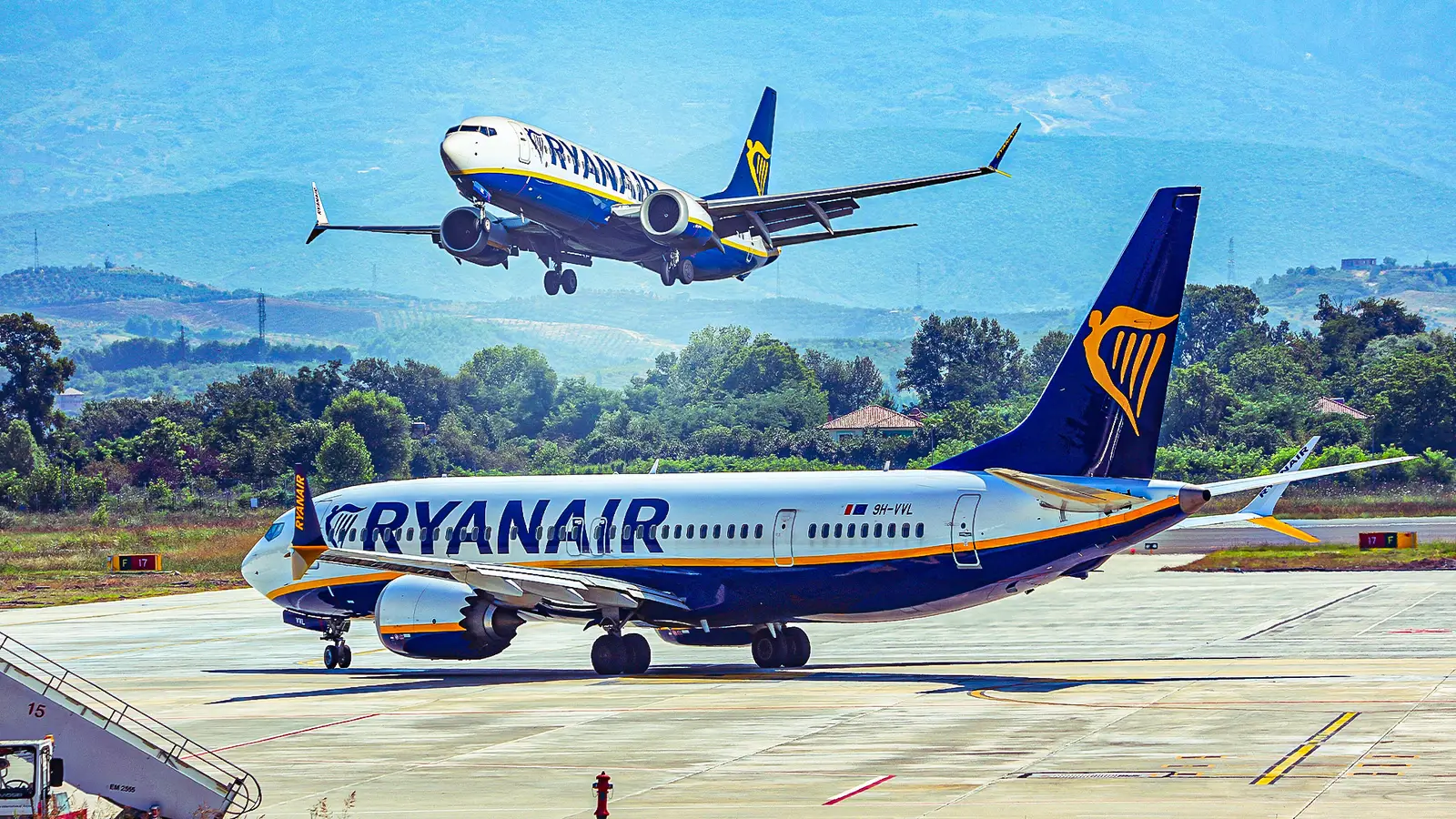Copyright Simple Flying

Ryanair’s fleet of Boeing 737 MAX 8-200 aircraft has quickly become the backbone of the airline’s short-haul operations across Europe. Known for their improved fuel efficiency and increased seating capacity, these jets are deployed on some of Ryanair’s most popular and high-demand routes. With hubs spread across key airports like Dublin, Stansted, and Faro, the 737 MAX 8-200 helps the airline maintain a dense network of frequent, high-capacity flights connecting leisure destinations and major cities. An analysis of recent operational data from Cirium reveals the most frequently flown nonstop routes operated by Ryanair’s 737 MAX 8-200. These routes represent not only Ryanair’s busiest corridors but also highlight the airline’s strategic focus on connecting popular holiday spots with key home markets. Below are the top ten most active routes, listed in order of flight frequency. 1 Dublin - Faro Total Frequencies: 1,675 The Dublin Airport– Faro Airportround-trip tops the list as Ryanair’s most heavily operated MAX 8-200 route. Together, both directions recorded 1,675 flights and nearly 330,000 available seats. This link between Ireland and Portugal’s Algarve coast remains the quintessential leisure corridor in Ryanair’s network. Irish holidaymakers flock to Faro throughout the year, while Portuguese travellers and workers in Ireland provide strong return traffic. This balanced flow ensures aircraft are well-utilized in both directions, keeping load factors high. The 737 MAX 8-200’s larger capacity allows Ryanair to absorb peak summer demand efficiently, maintaining frequent service while sustaining its trademark low fares. 2 Dublin - Malaga Total Frequencies: 1,637 The connection between Dublin Airport and Málaga Airport ranks second, with over 1,600 flights and more than 322,000 seats. Málaga, the gateway to Spain’s Costa del Sol, remains one of Ryanair’s strongest year-round sun destinations. The route serves a blend of Irish tourists, Spanish residents, and expatriates who travel regularly between the two countries. This consistent two-way demand helps Ryanair maintain multiple daily frequencies, especially during peak seasons. By using the MAX 8-200 on this 3-hour sector, Ryanair maximizes efficiency on one of its most profitable medium-haul leisure routes, achieving strong cost-per-seat economics. 3 London Stansted - Tenerife South Total Frequencies: 1,443 Ryanair’s London Stansted Airport– Tenerife South Airportservice is its busiest UK-Canary Islands pairing, operating 1,443 flights with nearly 285,000 seats. The route is vital for British winter-sun tourism and holiday packages. Demand remains steady throughout the year, as Tenerife offers a warm climate even in midwinter. The route also caters to long-stay travellers and expatriates with properties on the island. Ryanair fleet from Planespotters.net Thanks to the MAX 8-200’s extended range and fuel efficiency, Ryanair can operate this four-hour route profitably year-round, something that was more challenging with older 737-800s. 4 Dublin - Edinburgh Total Frequencies: 1,240 The Dublin Airport– Edinburgh Airport connection is Ryanair’s busiest short-haul inter-capital route, offering 1,240 flights and more than 244,000 seats. It’s a key link between Ireland and Scotland, used heavily by both business and leisure travelers. The flight time is under an hour, making it ideal for quick trips, sporting events, or weekend breaks. Frequent schedules and competitive pricing have made flying the default option over sea crossings. The MAX 8-200 provides a quieter cabin and greater efficiency on this ultra-short route, helping Ryanair maintain margins while keeping fares low for passengers. 5 Manchester - Alicante Total Frequencies: 1,232 Connecting the north of England with Spain’s Costa Blanca, Manchester Airport– Alicante-Elche Airport is a cornerstone of Ryanair’s UK–Spain network. With 1,232 flights and more than 242,000 seats, it remains a year-round favorite among British travelers. The route serves holidaymakers in summer and a large expatriate population through the rest of the year, maintaining high occupancy even off-peak. Ryanair’s use of the MAX 8-200 on this route allows for greater seating capacity and improved unit costs, enabling the airline to maintain multiple daily services without compromising profitability. 6 Dublin - Stansted Total Frequencies: 1,205 The Dublin Airport– London Stansted Airport roundtrip remains one of Ryanair’s original core routes, linking its Irish home base with its largest UK hub. With over 1,200 flights and 237,000 seats, it plays a strategic role in connecting two major operational centers. This short, high-frequency sector is crucial for both business travel and connecting passengers across Ryanair’s broader European network. The MAX 8-200’s low per-seat cost makes it ideal for such dense, competitive markets, helping Ryanair maintain strong frequencies even as costs rise elsewhere in the industry. 7 Stansted - Alicante [Total Frequencies: 1,123 London Stansted Airport– Alicante-Elche Airport continues to be a powerhouse in Ryanair’s UK leisure portfolio, with 1,110 flights and around 220,000 seats. Alicante remains one of the busiest Spanish airports in the Ryanair network. Both British holidaymakers and long-term residents favor this route along Spain’s southeastern coast. Demand remains strong across all seasons, aided by Ryanair’s reliable scheduling and competitive pricing. The MAX 8-200 enables Ryanair to operate these flights more efficiently, offering both environmental benefits and higher capacity for the UK’s busiest outbound leisure market. 8 Luton - Dublin Total Frequencies: 1,118 The London Luton Airport– Dublin Airport route stands out as another busy short-haul link operated by the MAX 8-200. With more than 1,100 combined flights and over 220,000 available seats. Luton’s location north of London attracts budget-conscious travellers from across the Midlands and southeast England, while Dublin remains one of Ryanair’s primary gateways for connecting flights throughout Europe. The route’s balanced two-way demand ensures consistently high load factors year-round, with commuters, weekend travellers, and visiting family members making up a large share of passengers. Deploying the high-capacity, fuel-efficient 737 MAX 8-200 on this route allows Ryanair to maximize revenue per flight while keeping fares among the lowest in the market. The combination of short turnaround times, strong frequency, and operational reliability has cemented Luton–Dublin as one of Ryanair’s most strategically important intra-European corridors. 9 Stansted - Málaga Total Frequencies: 1,024 The London Stansted Airport– Málaga Airport route remains one of the busiest and most important air links between Britain and Spain’s Costa del Sol, with more than a thousand combined flights operated annually. It continues to rank among the UK’s most popular sun routes, connecting travelers to one of Southern Europe’s top holiday destinations. The market is driven primarily by leisure travelers, second-home owners, and weekend city-break visitors, all of whom contribute to consistently high load factors throughout the year. Seasonal peaks in summer and during holiday periods further underline the route’s popularity and profitability. By deploying the 737 MAX 8-200 on this sector, Ryanair can offer increased seating capacity, improved fuel efficiency, and lower per-passenger operating costs. This not only enhances the airline’s competitiveness but also reinforces its strong position on a key leisure corridor that remains central to its European network strategy. 10 Manchester - Tenerife South Total Frequencies: 1,024 This long-haul short-sector route connects northern England directly to the Canary Islands, operating around 1,000 flights with roughly 200,000 seats. Tenerife’s year-round appeal keeps planes full even through winter. The sector length pushes the limits of Ryanair’s short-haul network, making the MAX 8-200’s range and fuel savings especially valuable. This pairing reflects Ryanair’s strategy of extending low-cost connectivity beyond the European mainland while maintaining high utilization on longer flights. 737 MAX 8-200 Future Ryanair’s adoption of the Boeing 737 MAX 8-200 marks a pivotal step in its evolution from a budget challenger to a dominant European network carrier. With its higher seat density and improved fuel efficiency, the “Gamechanger” enables Ryanair to operate its most popular leisure and capital city routes with unmatched cost efficiency. These aircraft have allowed the airline to expand capacity without sacrificing its hallmark low fares, even as operating costs rise across the industry. The routes featured in this list reveal where Ryanair’s core strength lies, connecting major markets in Ireland and the UK with sun-drenched Southern Europe. The MAX 8-200 has become central to sustaining the frequency and reliability demanded on these sectors, many of which operate multiple times daily. Whether flying Irish holidaymakers to the Algarve, Britons to the Canary Islands, or commuters between Dublin and Edinburgh, the aircraft is the workhorse driving Ryanair’s network resilience and profitability. Looking forward, the continued rollout of the 737 MAX 8-200 will solidify Ryanair’s position as Europe’s most efficient airline. The type’s superior economics and environmental performance provide a foundation for long-term growth, allowing Ryanair to expand into new markets while maintaining its ultra-low-cost structure. As the fleet grows, expect these top-performing routes to remain the airline’s strategic anchors, the beating heart of a network built on affordability, scale, and relentless operational efficiency.



